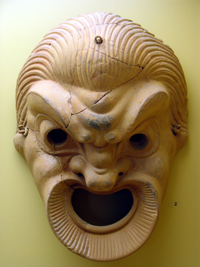|

model of a Tragedy mask |
Masks
Masks were made of gluey strips
of linen, places over the actor's face. When they set they had the shape of
the face and so fit very neatly. They were then painted. Some of these faces
were quite grotesque, especially for comedies. We have a number of models of
these masks made of terracotta (clay), and some pictures on vases show
masks.
Because they wore,
it was not possible to see the facial expressions of the actors, which meant
they had to act 'big', with gestures and movements. It wasn't always easy to
tell who was talking, either - especially if you were sitting right at the
back of the theatre. But the masks helped those at the back to see the
actors and their masks' expressions.
|

model of a comedy mask
|
|
Scenery
According to Aristotle (a
philosopher), Sophocles invented scene painting. Wooden boards were painted
to look like the setting the action was taking place in. The picture shows a
painting of such scenery.
Sometimes special moving scenery
was used, such as an eccyclema, which could spin round to show
someone on the other side, like a revolving door. Sometimes cranes were used
to lift actors into the air (like Medea at the end of the play).
|
 |
 |
![]()
![]()
![]()
![]()
![]()
![]()
![]()
![]()
![]()